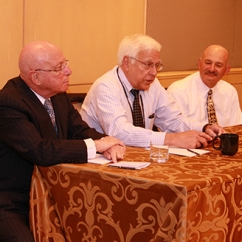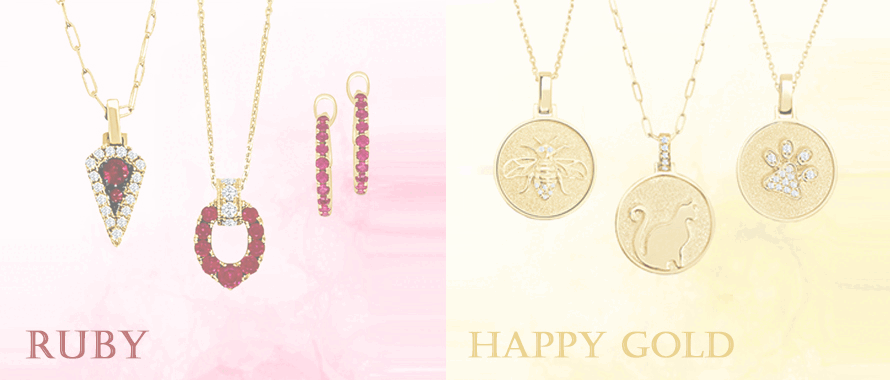Articles and News
Centurion Scottsdale Addresses “Generations” As Its Theme; Workshops Help With Planning Transitions | February 02, 2017 (0 comments)

Scottsdale, AZ—The Centurion Scottsdale show kicked off its Generations theme for 2017 with two very early morning sessions giving retailers a chance to exchange dialogue with industry experts in transition planning. Sessions were presented by Ira Bergman of The Gordon Co., Dan Pharr of Pharr Valuations, and Bill Boyajian of Bill Boyajian and Associates, left, and Kate Peterson of Performance Concepts.
In the session with Boyajian, Pharr, and Bergman, each of the three presented a 10-minute overview of their particular area of expertise: Boyajian in family dynamics and organizational structure, Pharr in business valuation, and Bergman in ways to reduce inventory and raise cash.
A big question is “Can you retire?” said Boyajian. “Can you afford to retire financially, and can you retire emotionally or is your identity wrapped up in the business?” He related the tale of a client—a grand patriarch of a jewelry business who had trouble envisioning a life outside the business—and who found the solution to be bringing in outsiders to serve on a board of directors of the business while his successor worked a buyout over the course of 10 years.
Another family Boyajian worked with had two sons, one of which is a Millennial-age child that didn’t really like the business but would float in and out as his needs for income dictated. Boyajian told the owners they had to make the hard decision and leave that child out since he wasn’t really committed to the the business, he was just in it when he had no other means of supporting himself. The parents brought in their elder son to take over and slowly stepped back
The third example Boyajian gave was a mom-and-pop couple who couldn’t afford to retire. He recommended they find a good manager they could groom to take over the business in time. Give him more responsibility along the way, said Boyajian, and the owners should make it a point to scale back—don’t come in before 10 a.m. and be sure to leave by 4 p.m. so that the manager had responsibility and a clear transition of power over to him.
“If people are capable and want to work, that’s the way to go,” he said. Couples that can’t really afford to retire can get a nice annuity from the business and go do what they want, such as one couple he is working with that are both 67 years old.
“That’s late in game. I like to see them start doing that at 57, not 67. But business transition is about having a basic plan and working the plan. There’s no set right or wrong, and what’s good for one family or business is not always right for another,” he finished.
Dan Pharr of Pharr Valuations discussed how to put a value on a retail jewelry business.
“I always remind everyone that one of these days you’re going to leave your business. It may be vertical or it may be horizontal, but you are going to leave. That’s why succession planning is important.”
Pharr, a CPA, also has two additional certifications allowing him to do business valuations. The former CFO of Hoover & Strong, he also is a past board chair of JBT and remains on one of its advisory committees.
“Business valuation is an unbiased independent appraisal of a business entity or interest, using generally accepted valuation standards, approaches, and methods,” he explained. There are two types of valuations; one more and one less in-depth. The first, which results in an in-depth report of 65-100 pages that evaluates financial, industry, and economic information to derive the value of a company.
A second report is called a calculation valuation and is 25-30 pages. It’s less in-depth but does provide a valuation based on numbers and not opinion or additional factors.
“Why would you want or need a business valuation?” he asked. “The truth is, nobody ever wants a valuation. Most people get one when their investment advisor, attorney, or business consultant tells them to. But you need one because if you’re passing the business down to your children, either as a gift or through a sale, you have to have valuation to support the value of the gift or for the estate tax return, or you need one for buy/sell agreements.”
He said often people will agree to a buy and sell, agree the business is worth X, then put that in a drawer and don’t look at it for years until a trigger event happens, then they pull it out and all they see is an old evaluation, he said.
The third reason one is needed is for sales and acquisitions. If you’re selling the business, you want to get the maximum return and if you’re buying it, you need to know where to start to pay a fair price.
Pharr related how he was called to do an evaluation on an estate. The family had done everything right: the father started the company, his daughter came in and a few years later his son came in. The father gave each of the kids 24% of the company and put 52% into a limited partnership for himself. At his death, his portion was to be split up so the daughter would get 51% and the son would have 49%. So far, so good.
But on the father’s 70th birthday, he went for a swim and suffered a heart attack in the pool. The daughter jumped in to try and save him, and in so doing hit her head on the side of the pool. The father died and 10 minutes later the daughter died.
“For 10 minutes, she owned 51% of the company and her brother 49%. 10 minutes later, her estate—left to her husband, the business’s sales manager—owned 51% of the business. It took three years to straighten everything out to get the son majority ownership,” said Pharr, adding, “this is entirely true! I couldn’t have made this stuff up!”
Ira Bergman, president of The Gordon Co., talks to 10-20 retailers a week about how to keep a business strong so that when the times comes to transition there is something of value to pass on. “With things in the industry a little shaky—and things in general a little shaky—the most common question they ask is, “How do I perpetuate the business I have now so that there is something worthwhile to either pass on or dispose of?
“The number-two question people ask is how to get more people into my store, and number three is how do I move more inventory to keep fresh product coming in all the time and keep the public coming in?”
The answers are a lot of what retailers already know, he says: get involved with the public more, do promotional events, and so forth. It has to be an ongoing effort. “Retailing changes so dramatically that you can’t say ‘Am I going to have a good Christmas and therefore good year?’ You can’t wait till then—and sometimes all your fate is in that last week! All year long you should be interacting with consumers and bringing them to your store.
“The greater value the business has, the much greater choice it will give you when the time does come [to leave.]
Audience questions comprised half of the hour. Some of the recurring themes were:
1. How do you get your employees ready to deal with changes and shifts?
Bill Boyajian: If you have a child in the business, I highly recommend they work elsewhere for a while before joining your business. They will come in with more insight and if they’re going to make mistakes they’ll make them somewhere else. They also won’t act so entitled. I used to tell GIA students, ‘Don’t leave with six months of gemological knowledge and tell your parents how to run the business.’
The kids have to earn the respect of the employees. To win their favor and respect, they have to lead the business. Employees may love the patriarch and sometimes the son or daughter comes in with a different management style, but they have to be a good leader. They can’t lord it over the employees.
Dan Pharr: If they work somewhere their last name is not on the door, they learn to behave. [In their own store] even if parents tell the employees to treat the kid like any other employee, that’s not going to happen because the employees know the kid might someday be their boss.
Ira Bergman: It depends on the kid coming in and the nature of their personality. My dad was tough act to follow, but I went out of my way to be one of the people that came in early and left late and did everything every other employee did.
2. Many stores have an illusion of what their inventory is worth. What is typical that you see as value of inventory?
Dan Pharr: One key thing is to keep your inventory current. I do lots of valuations and I ask people why they still have this piece from 20 years ago. It hasn’t sold in 20 years, it’s not going to sell tomorrow! Look at your inventory, see its age, have an inventory reduction sale or send it to a refiner, but do something to generate cash.
The value of a jewelry store is not just the jewelry but a combination of your reputation over the years and a cash flow formula I use. There’s a trust factor people have when they come to you, so the value of that business is worth more than the inventory but you have to keep it current or you’re going to have a lot of money tied up in it.
I remember one instance where the owner had passed and an employee was looking to buy the business. The owner had gotten into the metal purchasing business. He went from a jeweler that occasionally bought metal to a metal buyer who occasionally sold jewelry. After he passed, the person buying offered $30,000 for the furniture and fixtures and said ‘send all the inventory to a refiner and put the money toward the estate because I don’t want it.’
Bill Boyajian: In my experience, the number-one problem in the inventory is aged and underperforming inventory sitting around. Tens or hundreds of millions of dollars’ worth of inventory is sitting around in jewelry stores. That’s precious capital tied up in product hasn’t sold and will not sell.
Because of the situation with banks today and lines of credit being pulled, we are in a cash-intensive business. It’s crucial you have a plan each year to ove product, scrap inventory, do whatever you have to do to keep it current. Reorder fast-selling merchandise constantly. People laugh, but it’s key to keeping your cash flow.
Ira Bergman: We recommend to retailers that the first thing they do is to do an inventory-aging report and actually see what the age of their inventory is. If you have something that’s been there for 10 or more years, it’s not what you think the cost is. If you are trying to get a true valuation of your inventory, do an aging report first. That will tell you a lot. You should be disposing of the oldest pieces, not hoping someone will come in and buy them eventually.
3. Is anyone buying jewelry stores anymore? Are they worth anything more than inventory?
Bill Boyajian: The first problem is, who has money to buy it, and what’s it really worth? I was speaking at the RJO show and ran into a son and daughter who wanted to buy their father’s business. I looked at the numbers and said, “unless you’re trying to do your father a service, he doesn’t have a business.” The trouble with a $600,000 business is that it’s so much sweat and toil for $50,000 or $60,000 for mom and dad. I told them if you want to help your parents, ok, but you have to entirely retool the business for Millennials or it’s not worth buying.
Ira Bergman: We have a situation right now where 10 years ago there were 8 – 10 bankis willing to lend to the industry and today it’s down to three and they make it so hard. The rules and regulations everyone has to follow are so stringent that not everyone can find a place to secure funds right now. A buyer that wants to buy a store somewhere else may be able to get financing slightly easier, but in general the banking industry has not looked kindly on the jewelry industry for a bit of a time.
Dan Pharr: I had several conversations with bankers outside jewelry industry. All will say ‘we have money to lend.’ I said, why not finish the sentence ‘but not to you.’
If you are looking to sell a business, you need to plan on taking some of the paper back. You have to plan on a bank not lending the full value to the buyer.
From a valuation standpoint, it’s hard to say a busiess should sell for X times sales or X times revenues. There is no average business; you have to look at each individual business and those percentages can change on each case.
Bill Boyajian: I have two clients where my biggest fear is that the owners built the business and each sells 80% to 90% of book for the business. Nobody could buy the business because they are the business I’m working with them to transition and build a staff so others can sell and have a book of business of at least $1 million in a $7 million business.
The three consultants agreed most businesses can’t be sold, which is why there are so many going out of business and retirement sales. It’s also one way to liquidate inventory that’s dated or aged and good to bring in other product that will sell to augment it.
They all also urge stores considering a transition to bring in a consultant to help get their business into better shape to pass on.
“Some people say we’re too late on the curve,” said Boyajian. “I say it’s better to start today with someone and have a three to five year plan to have something worthwhile.” Big chain jewelers like Zales and Kay that used to buy up independent and small private chains are no longer doing that. A better bet, says Boyajian, is a well-capitalized family business within 100 miles that is looking to grow. Look for one that has three stores or so and wants to expand in the region.
The flip side is that sometimes businesses that want to expand have owners or family members that don’t want to move. Boyajian says, “well, if you want to be in business you have to be aggressive. I think growth will come from well-capitalized family businesses taking over market share from smaller stores going out of business.
4. What about selling to an employee?
Bill Boyajian: A lot of owners think don’t have options but they often have more than they think. As Dan says, you may have to take some paper back and maybe have some risk, but you have to do something. A lot of times owners are stuck with a risk factor, but my suggestion is to take less of a day-to-day operation and be involved otherwise. One of my clients has a president that makes $250,000 with a bonus to run the business. They make a lot of money and only go to board meetings twice a month.
I’m not a big believer in cold turkey retirement. In my mind, you should keep your mind engaged and stay active. I’m 64, I want to stay engaged, but I don’t want to work as hard as I did at 54 or 44.
Dan Pharr: If you do decide to turn the business over to a kid or an employee, you stay there long enough to transition and turn good or repeat clients over to them. The business will do much better if you transition than if you hand over the keys and say ‘good luck.’ Having a transition where customers are comfortable with the new leader taking over is much better.
A detailed summary of Peterson’s session will be presented in next week’s edition.







